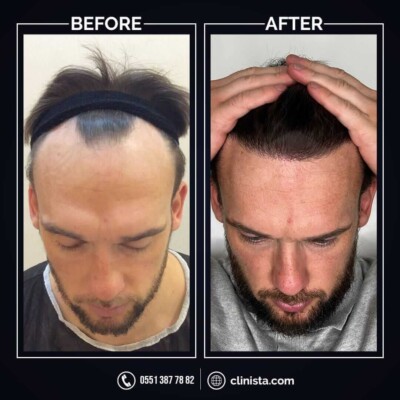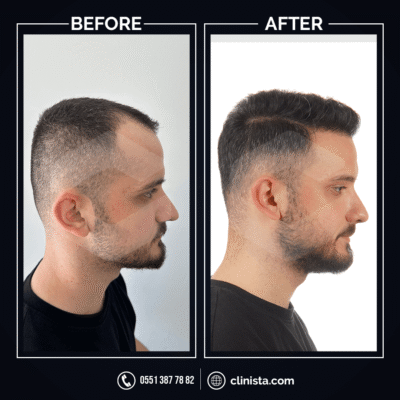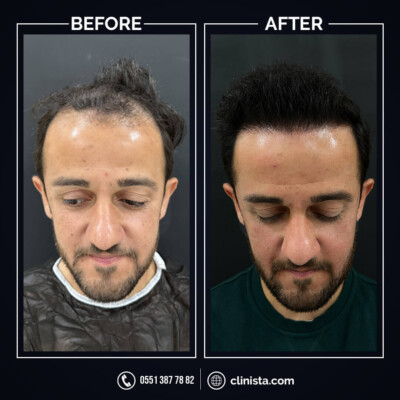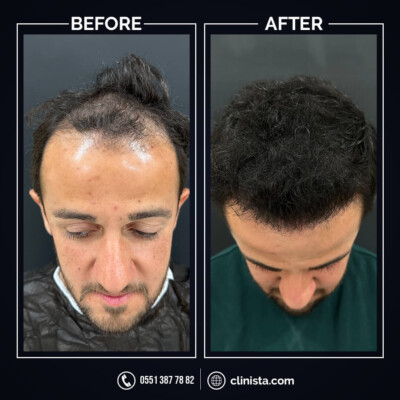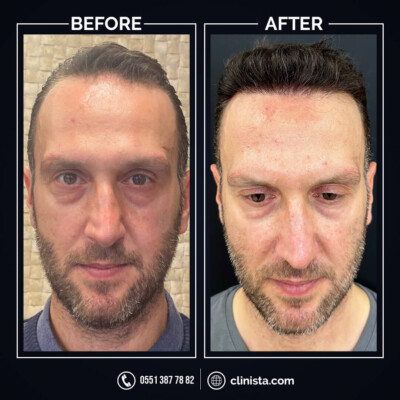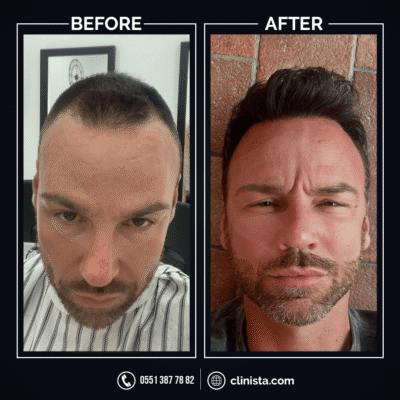FUE Hair Transplant in Turkey – Micro-Graft Technique Explained

FUE hair transplant is today’s most requested hair restoration technique. Using micro-punches, individual follicular units are harvested—usually from the safe donor zone at the nape—and redistributed to thinning areas. Thanks to tiny instruments (0.6–0.7 mm), donor micro-wounds typically seal in 24–48 hours, most patients return to work on day 3, and normal routines resume by day ~10. Below, we explain how Micro-Graft FUE works, who is a good candidate, the step-by-step process, and answers to frequent questions.
What Is FUE Hair Transplant?
FUE hair transplant (Follicular Unit Extraction) removes follicular units one-by-one and implants them into micro-channels created at the desired angle and direction. Compared with older strip methods, FUE avoids a linear scar, enables short hairstyles, and offers a smoother recovery. At Clinista, we use Micro-Graft FUE—third-generation punches and atraumatic handling—to minimize tissue trauma and maximize graft survival.
How a FUE Hair Transplant Is Performed (Step by Step)
- Assessment: A specialist reviews medical history, medications, and hair-loss pattern to confirm candidacy and goals.
- Pre-op briefing: You receive instructions (washing, food/meds, clothing) and the surgery schedule is confirmed.
- Admission & labs: On the day, you arrive at our university-hospital setting; routine blood tests and preparation begin.
- Shaving plan: Full or partial trim; for non-shaven plans, we brief you in clinic and trim only as needed.
- Local anesthesia: Donor area is numbed; micro-punch extraction (≈0.6–0.7 mm) begins.
- Graft handling: Follicles are counted and held in protective solutions under controlled conditions.
- Recipient anesthesia: Target area is numbed. Micro-channels are opened to match native direction and density goals.
- Implantation: Healthy follicles are placed one-by-one for a natural hairline and balanced coverage.
- Medications & dressing: You receive antibiotics/analgesics; donor is dressed and the plan for next-day care is set.
- First wash & training: Performed at the hospital; you’re shown the 10-day washing routine.
Benefits of Micro-Graft FUE
- Local anesthesia; typical session ~6–7 hours
- Third-generation 0.6–0.7 mm punches; donor seals in 48–72 hours
- Reduced tissue trauma; shorter downtime
- Initial growth from month 3–4; cosmetic change by month 6; near-final result by month 12
Who Is a Candidate?
We differentiate active vs. passive hair loss. In the active phase, borders expand; surgery does not stop miniaturization, so we pair a FUE hair transplant with medical therapy and stage zones conservatively. In passive, well-defined recessions, immediate grafting yields more predictable results. Crown/mid-scalp often benefit from stabilization first, with a second stage once borders settle.
What Results to Expect
With proper planning and donor quality, a FUE hair transplant in a fully bald area can restore about 50–60% of native-like density, which the eye perceives as full when distribution and angulation are correct. Typical graft survival is higher in frontal/mid-scalp (≈85–90%) than vertex (≈60–70%), assuming no complicating factors (infection, endocrine disorders, chemotherapy). Realistic expectations and a maintenance plan protect the long-term look.
For patient-friendly overviews of hair loss and treatment options, visit the
American Academy of Dermatology.
Considering a FUE hair transplant at Clinista? Explore our hair loss treatments or learn about our FUE approach. Ready to plan your case?
Contact us to book a consultation.

Frequently Asked Questions About FUE Hair Transplantation
Can I achieve natural-looking hair after a hair transplant?
With an experienced surgeon, proper planning, and suitability for the procedure, achieving a natural-looking result is possible. A well-planned FUE hair transplant should be indistinguishable from native growth.
Is hair transplantation a painful procedure?
With modern anesthetic medications and application techniques, pain is well controlled. While minor, temporary pain may be felt during the injection of anesthesia, it typically lasts only seconds. Once the anesthesia takes effect within 5–10 minutes, no pain is usually felt during the procedure. Additionally, psychological preparation for pain is important, and stress management methods, including verbal reassurance or medication, may be necessary for anxious patients.
How soon can I return to normal life after a hair transplant?
While healing speeds vary from person to person, the first wash is typically performed on the second or third day. Redness and scabbing may be noticeable in the recipient and donor areas, requiring some camouflage if necessary. However, unless engaging in intense physical activity, most patients can return to their daily routines soon after the procedure.
Will my existing hair fall out after the procedure?
Yes, temporary “shock loss” may occur in both the donor and recipient areas. Some healthy hair follicles may suffer minor trauma during extraction and transplantation. This is a temporary condition, and hair generally returns to normal within three months, growing along with the transplanted hairs.
When will my transplanted hair start growing?
While a general timeline of 3–6 months is often mentioned, plastic surgery associations and medical literature suggest that the full process takes 12–15 months. Initially, transplanted hairs may grow thin, curly, or resemble body hair, but this appearance normalizes over time.
Should every type of hair loss be treated with a hair transplant?
No. Hair loss can occur due to various reasons, including early-age hair loss, postpartum shedding, infections, major surgeries, medication use, or endocrine disorders. A dermatologist or trichology specialist should diagnose the type of hair loss through one or more tests. Some hair loss types can be treated with simple medical therapies, while others may require complex and lengthy procedures. Before deciding on a transplant, a specialist should outline the most suitable treatment plan.
Will all transplanted hairs grow?
If no complications such as infection, trauma, endocrine disorders, or chemotherapy occur, transplanted hair generally grows at a rate of:
- 85–90% in the frontal and mid-scalp regions
- 60–70% in the vertex (crown) area
What should I realistically expect from a hair transplant?
A successful FUE hair transplant can provide a density increase of 50–60% in a completely bald area, depending on age, gender, skin tone, hair thickness, and donor area density. It is essential to set realistic expectations and communicate openly about achievable results. While hair transplantation cannot fully restore a 100% natural hair density, the human eye cannot distinguish between 60% and 100% hair density when distribution and angulation are correct. Donor-area scarring should be minimal and barely noticeable.
Can poorly performed hair transplants be corrected?
Yes, unsatisfactory results—such as unnatural “toothbrush-like” growth—can be corrected with repair strategies. However, patients must acknowledge risks and accept responsibility for outcomes. Ethical surgeons may decline revision if the risks outweigh potential benefits.
What are the mandatory standards in hair transplantation?
- The operation must be supervised by a licensed medical doctor.
- Healthcare professionals or nurses should assist in the procedure.
- The procedure must be conducted in a surgical environment that meets operating room conditions (hospital, sterilization, pain control, IV access).
- The facility must be equipped for emergency interventions, with the necessary medical team present.
- Post-operative follow-up should be conducted by the surgical team, not by agents or consultants.
Book Your FUE Consultation
Take the first step toward a natural, lasting result. Tell us your goals, and we’ll map a phased plan that fits your pattern, donor capacity, and timeline.

